
Peloids are allochems that are composed of micrite, irrespective of size, shape, or origin. The two primary types of peloids are pellets and intraclasts. Another type of peloid is pseudo-oolith. [1] [2] [3]

Peloids are allochems that are composed of micrite, irrespective of size, shape, or origin. The two primary types of peloids are pellets and intraclasts. Another type of peloid is pseudo-oolith. [1] [2] [3]

Limestone is a type of carbonate sedimentary rock which is the main source of the material lime. It is composed mostly of the minerals calcite and aragonite, which are different crystal forms of CaCO3. Limestone forms when these minerals precipitate out of water containing dissolved calcium. This can take place through both biological and nonbiological processes, though biological processes, such as the accumulation of corals and shells in the sea, have likely been more important for the last 540 million years. Limestone often contains fossils which provide scientists with information on ancient environments and on the evolution of life.

Sandstone is a clastic sedimentary rock composed mainly of sand-sized silicate grains. Sandstones comprise about 20–25% of all sedimentary rocks.

North Sea oil is a mixture of hydrocarbons, comprising liquid petroleum and natural gas, produced from petroleum reservoirs beneath the North Sea.
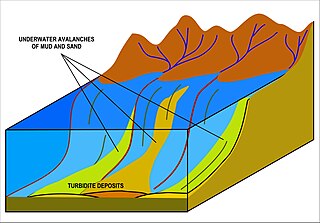
A turbidite is the geologic deposit of a turbidity current, which is a type of amalgamation of fluidal and sediment gravity flow responsible for distributing vast amounts of clastic sediment into the deep ocean.

Long Forties is a zone of the northern North Sea that is fairly consistently forty fathoms deep.

Allochem is a term introduced by Folk to describe the recognisable "grains" in carbonate rocks. Any fragment from around 0.5 mm upwards in size may be considered an allochem. Examples would include ooids, peloids, oncolites, pellets, fossil or pre-existing carbonate fragments. Fragments are still termed allochems if they have undergone chemical transformations – for example if an aragonite shell were to dissolve and be later replaced by calcite, the replacement would still be deemed an allochem.
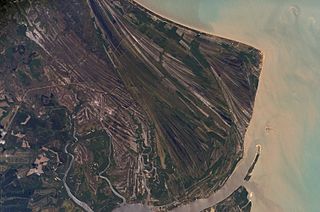
A strand plain or strandplain is a broad belt of sand along a shoreline with a surface exhibiting well-defined parallel or semi-parallel sand ridges separated by shallow swales. A strand plain differs from a barrier island in that it lacks either the lagoons or tidal marshes that separate a barrier island from the shoreline to which the strand plain is directly attached. Also, the tidal channels and inlets which cut through barrier islands are absent. Strand plains typically are created by the redistribution by waves and longshore currents of coarse sediment on either side of a river mouth. Thus, they are part of one type of wave-dominated delta.

Raymond Alexander Price, is a Canadian geologist. He has used his research on the structure and tectonics of North America’s lithosphere to produce extensive geological maps. He has also provided guidance for nuclear fuel waste disposal and reports on the human contribution to Global warming.
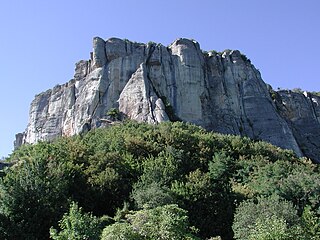
Calcarenite is a type of limestone that is composed predominantly, more than 50 percent, of detrital (transported) sand-size, carbonate grains. The grains consist of sand-size grains of either corals, shells, ooids, intraclasts, pellets, fragments of older limestones and dolomites, other carbonate grains, or some combination of these. Calcarenite is the carbonate equivalent of a sandstone. The term calcarenite was originally proposed in 1903 by Grabau as a part of his calcilutite, calcarenite and calcirudite carbonate classification system based upon the size of the detrital grains composing a limestone. Calcarenites can accumulate in a wide variety of marine and non-marine environments. They can consist of grains of carbonate that have accumulated either as coastal sand dunes (eolianites), beaches, offshore bars and shoals, turbidites, or other depositional settings.

Beachrock is a friable to well-cemented sedimentary rock that consists of a variable mixture of gravel-, sand-, and silt-sized sediment that is cemented with carbonate minerals and has formed along a shoreline. Depending on location, the sediment that is cemented to form beachrock can consist of a variable mixture of shells, coral fragments, rock fragments of different types, and other materials. It can contain scattered artifacts, pieces of wood, and coconuts. Beachrock typically forms within the intertidal zone within tropical or semitropical regions. However, Quaternary beachrock is also found as far north and south as 60° latitude.

Micrite is a limestone constituent formed of calcareous particles ranging in diameter up to four μm formed by the recrystallization of lime mud.

William Embry Wrather was an American geologist.
The Beaverhill Lake Group is a geologic unit of Middle Devonian to Late Devonian age in the Western Canada Sedimentary Basin that is present in the southwestern Northwest Territories, northeastern British Columbia and Alberta. It was named by the geological staff of Imperial Oil in 1950 for Beaverhill Lake, Alberta, based on the core from a well that they had drilled southeast of the lake, near Ryley, Alberta.
The Ravenscrag Formation is a stratigraphic unit of early Paleocene age in the Western Canada Sedimentary Basin. It was named for the settlement of Ravenscrag, Saskatchewan, and was first described from outcrops at Ravenscrag Butte near the Frenchman River by N.B. Davis in 1918.
Calcisiltite is a type of limestone that is composed predominantly, more than 50 percent, of detrital (transported) silt-size carbonate grains. These grains consist either of the silt-size particles of ooids, fragments of fossil shells, fragments of older limestones and dolomites, intraclasts, pellets, other carbonate grains, or some combination of these. Calcisiltite is the carbonate equivalent of a siltstone. Calcisiltites can accumulate in a wide variety of coastal, lacustrine, and marine environments. It is typically the product of abrasion and bioerosion.
Calcirudite is a type of limestone that is composed predominantly, more than 50 percent, of carbonate grains that are larger in size than sand. The grains can consist of either fragments of fossils, fragments of older limestones and dolomites, other carbonate grains, or some combination of these. The term calcirudite was originally proposed in 1903 by Grabau as a part of his calcilutite, calcarenite and calcirudite classification system based upon the size of the detrital grains composing a limestone. Depending on roundness of the grains, calcirudite is the carbonate equivalent of either a breccia, in the case of predominantly angular grains, or conglomerate, in the case of predominantly rounded grains. Calcirudites can accumulate in a wide variety of coastal, lacustrine, and marine environments.
Calcilutite is a type of limestone that is composed of predominantly, more than 50 percent, of either clay-size or both silt-size and clay-size detrital (transported) carbonate grains. These grains consist either of fossil fragments, ooids, intraclasts, pellets, other grains, or some combination of them. The term calcilutite was originally proposed in 1903 by Grabau as a part of his calcilutite, calcarenite and calcirudite classification system based upon the size of the detrital grains composing a limestone. In the original classification of limestone according to the dominant grain-size, calcisiltites were not named and are classified as calcilutite. In this classification, which the majority of geologists follow, a calcilutite consists of both silt- and clay-size, less than 0.062 mm in diameter, grains. It is the carbonate equivalent of a mudstone. Calcilutites can accumulate in a wide variety of marine and lacustrine environments.
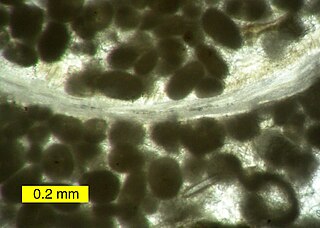
Pellets are small spherical to ovoid or rod-shaped grains that are common component of many limestones. They are typically 0.03 to 0.3 mm long and composed of carbonate mud (micrite). Their most common size is 0.04 to 0.08 mm. Pellets typically lack any internal structure and are remarkably uniform in size and shape in any single limestone sample. They consist either of aggregated carbonate mud, precipitated calcium carbonate, or a mixture of both. They either are or were composed either of aragonite, calcite, or a mixture of both. Also, pellets composed of either glauconite or phosphorite are common in marine sedimentary rocks. Pellets occur in Precambrian through Phanerozoic strata. They are an important component mainly in Phanerozoic strata. The consensus among sedimentologists and petrographers is that pellets are the fecal products of invertebrate organisms because of their constant size, shape, and extra-high content of organic matter.
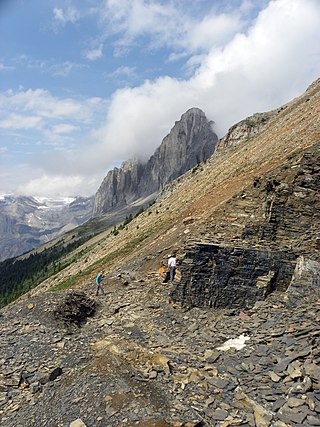
The Cathedral Formation is a stratigraphic unit in the southern Canadian Rockies of Alberta and British Columbia, on the western edge of the Western Canada Sedimentary Basin. It is a thick sequence of carbonate rocks of Middle Cambrian age. It was named for Cathedral Mountain in Yoho National Park by Charles Doolittle Walcott, the discoverer of the Burgess shale fossils.
Basanta Kumar Sahu is an Indian mathematical geologist, sedimentologist and a Professor Emeritus at the Indian Institute of Technology, Bombay. He is for known for his mathematical and quantitative studies in geology and the development of statistical and mathematical models. A founder member of the founded the International Association of Mathematical Geologists, he is a member of the American Association of Petroleum Geologists and the Society of Economic Paleontologists and Mineralogists. The Council of Scientific and Industrial Research, the apex agency of the Government of India for scientific research, awarded him the Shanti Swarup Bhatnagar Prize for Science and Technology, one of the highest Indian science awards for his contributions to Earth, Atmosphere, Ocean and Planetary Sciences in 1980.